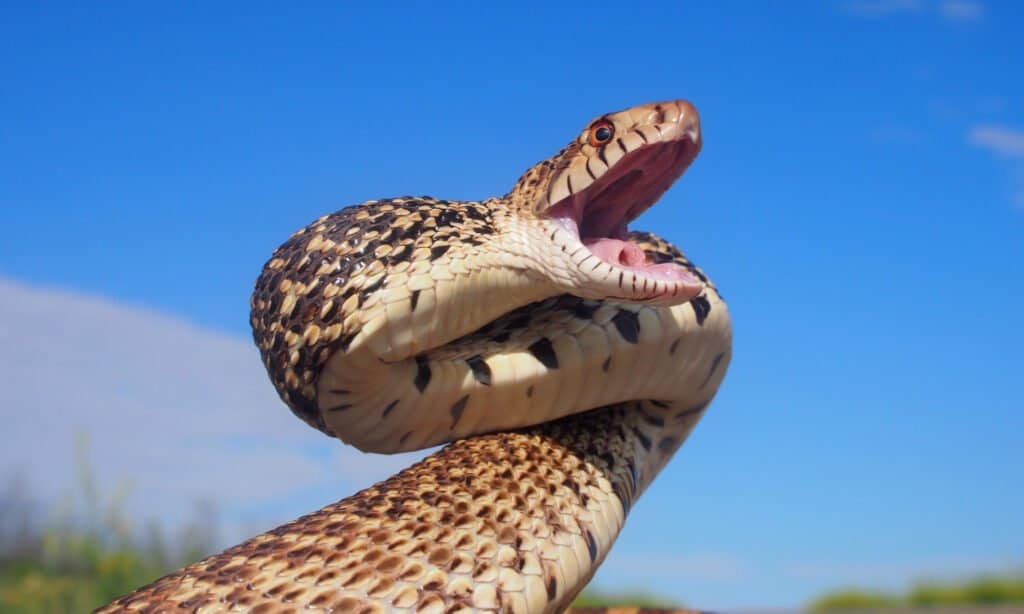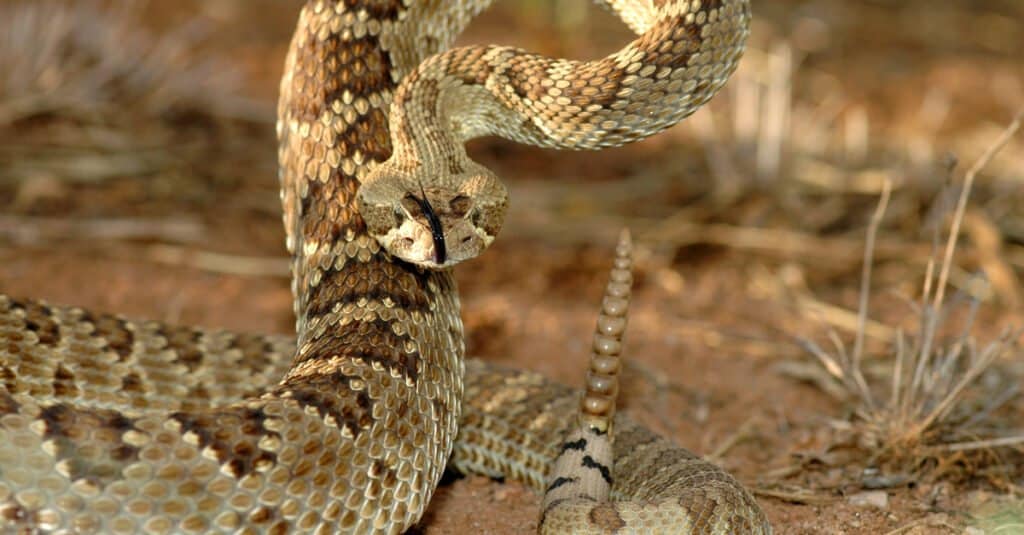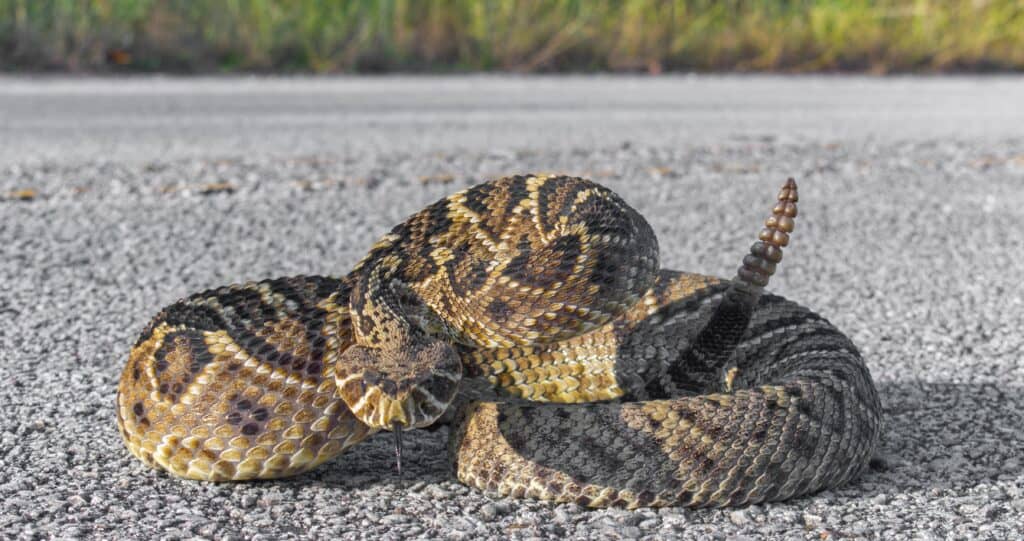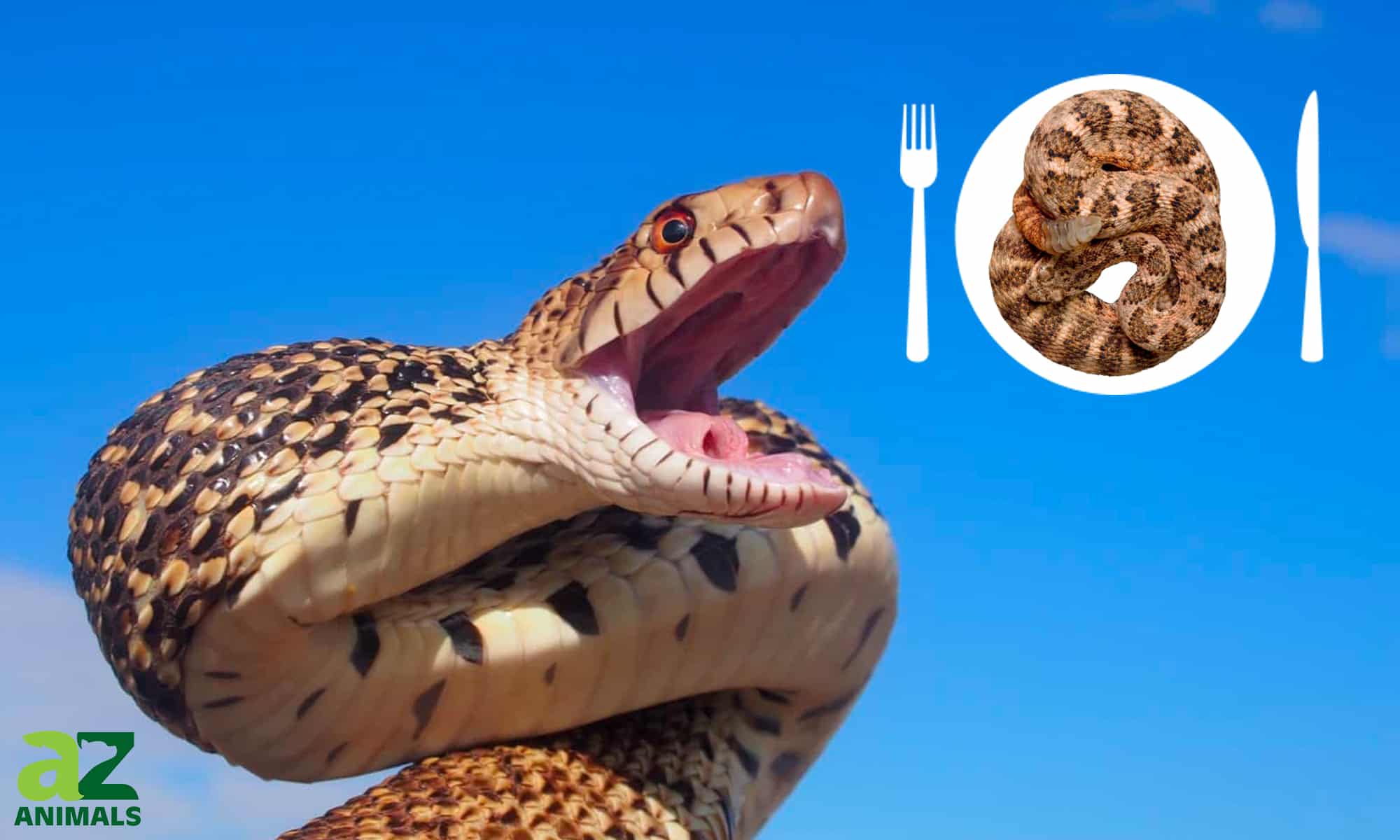Rattlesnakes are one of the scariest species of snake in North America. They’re common throughout the desert southwest, as well as all regions of the United States. They can even be found in Canada, Central America, and South America. They’re members of the pit viper family, so named for the heat-sensing pits located between their eyes and nostrils. Rattlesnakes may be scary, but many people wonder, do bullsnakes eat rattlesnakes?
Bullsnakes are similar to rattlesnakes in that they occupy many of the same areas. They eat the same things and grow to similar sizes. They even look similar—though bullsnakes lack one thing that rattlesnakes are widely known for. Like rattlesnakes, bullsnakes strike fear into the hearts of many—and they just may strike fear into the hearts of rattlesnakes too.
Here, we’ll learn more about the important differences between rattlesnakes and their less dangerous cousin, the bullsnake. Then, we’ll take a look at some of the more common myths surrounding the two. Finally, we’ll answer the big question: do bullsnakes eat rattlesnakes? After that, we’ll take a look at some of the other creatures that make a meal out of rattlesnakes, and what rattlesnakes like to eat too.
Bullsnake Vs. Rattlesnake: What’s the Difference?

Like rattlesnakes, bullsnakes can grow up to eight feet long. Both species have dusky yellow or brown bodies with diamond-like markings, but only the rattlesnake has a rattle. Additionally, rattlesnake heads are very different from bullsnake heads.
The head of a rattlesnake is designed to deliver venom, whereas bullsnakes are actually non-venomous. Bullsnake heads are narrow, not much wider than the width of their necks, and they lack the heat-sensing pits that rattlesnakes have. Rattlesnakes have spade-shaped heads that are very wide at the base. And, unlike bullsnakes, rattlesnakes have very large, retractable fangs at the front of their mouths. Though, hopefully, you won’t see them.
Do Bullsnakes Kill Rattlesnakes?

Bullnakes may look like rattlesnakes but lack fangs.
©Markparker1983/Shutterstock.com
Bullsnakes and rattlesnakes grow to about the same size, and occupy many of the same habitats, but do bullsnakes kill rattlesnakes? According to popular myth, they do. But, stories are often wrong, and so is this one.
No, bullsnakes do not kill rattlesnakes—they don’t hunt them down, and they don’t eat them. The sole exception to this is opportunity. For example; a hungry adult bullsnake might eat a newborn, or small, dead, rattlesnake, if given the opportunity.
Bullsnakes have a very similar diet to rattlesnakes: they both eat small mammals primarily. Their typical prey includes mice, rats, shrews, rabbits, and other pint-sized creatures. Bullsnakes will also eat birds and even amphibians. But, like rattlesnakes, they rarely eat other snakes.
What Are The Natural Bull Snake Predators?
While adult bullsnakes generally face few natural predators, on occasion, a large hawk or other predatory animal might target them. However, young bullsnakes are more vulnerable and often become prey for birds, mammals, and even other snakes. Like many snake species, bullsnakes can fall victim to predators such as weasels, coyotes, foxes, and a variety of birds of prey.
While foxes and other small to medium-sized animals such as dogs can kill a bullsnake, particularly large bullsnakes have the potential to capture and consume a small puppy, although they do not pose a threat to fully grown dogs.
Furthermore, even if a dog is bitten by a bullsnake, the bite does not carry any venom, and it is generally not life-threatening.
Do Bullsnakes Repel Rattlesnakes?
If you’ve heard that bullsnakes kill rattlesnakes, then you’ve probably also heard that bullsnakes repel rattlesnakes. Some people have even gone so far as to keep bullsnakes in their tents when camping, believing that this will keep them safe from rattlers. However, this is neither necessary nor true.
Bullsnakes do not repel rattlesnakes; they’re both snakes, and each species wants about the same thing out of life—to eat, and make little snakes. Bullsnakes and rattlesnakes may not be bosom buddies, but they don’t repel each other like bug spray to mosquitoes. Bullsnakes are, however, commonly mistaken for rattlesnakes, and are often killed by people who mistakenly think that all rattlesnakes should be killed on sight.
Do Bullsnakes and Rattlesnakes Mate?

Rattlesnakes may look like bullsnakes, but the two types of snakes don’t mate.
©Rusty Dodson/Shutterstock.com
Rattlesnakes share many commonalities with bullsnakes: size, habitat, and prey. However, rattlesnakes don’t lay eggs. Instead, the baby snakes incubate within a membrane until they’re fully formed, then the mother gives birth to her young. However, female bullsnakes lay eggs in sand and leave them to incubate on their own.
But, can bullsnakes and rattlesnakes produce offspring? The answer is: no. They may be very similar, but rattlers and bullsnakes are, in the end, different species, and don’t mate. They don’t seek each other out to make little snakes, and many have different, incompatible, mating rituals.
Bullsnakes aren’t big snake eaters. Sure, if they’re hungry enough, they may snack on a snake, but they generally prefer amphibians, rodents, and the occasional lizard. The same is true for rattlesnakes.
What Eats Rattlesnakes?

Predators of rattlesnakes include kingsnakes and roadrunners.
©Matt Jeppson/Shutterstock.com
Rattlesnakes don’t have much to fear, but they do have to watch out for a few creatures. Humans are probably at the top of this list, as they’re responsible for many unnecessary rattlesnake deaths. But, after humans, the rattlesnake’s greatest enemy is probably the kingsnake. Kingsnakes actively hunt rattlesnakes for supper, as do greater roadrunners. Both species are uniquely suited to attacking and killing rattlesnakes, despite their dangerous venom.
Interestingly, kingsnakes aren’t venomous like rattlesnakes, so they rely on constriction to kill their prey. So rattlesnakes can potentially use their venom to defend themselves from the slow strategy of kingsnakes. But the kingsnake’s tendency to eat other snakes is where its name derives.
After kingsnakes and rattlesnakes, species like the timber, prairie, and Mojave rattlesnake have to watch out for coyotes, guinea fowl, large birds of prey, and livestock. Cows and horses will stomp rattlesnakes to death if they’re startled, and many birds will snatch them from the ground for a meal.
What Do Rattlesnakes Eat?
Rattlesnakes are the great rodent hunters of North America. They’re so good at it that, without rattlesnakes, our rodent populations would explode, causing massive ecological damage. Some of the rattlesnake’s favorite foods include mice, rats, gophers, prairie dogs, and rabbits.
They’ll also eat small birds, amphibians, and lizards. Depending on where they live, rattlers also prey on bird eggs, swallowing them whole without having to worry about using any venom.
Because of their ability to control rodent populations, rattlesnakes are key components of many ecosystems. The human-led killing of them can lead to major imbalances. That’s why if you see a rattlesnake, or a bullsnake, try to leave it alone. Remember—snakes don’t want to hurt you, but they will act to defend themselves, if necessary.
What is the Lifespan of a Rattlesnake?

Despite the challenges they face, rattlesnakes play an important role in their ecosystems as both predators and prey.
©Chase D’animulls/Shutterstock.com
The rattlesnake is a venomous snake that is often found in different parts of the U.S. These Snakes are known for their distinctive rattles. Rattlesnakes have a fairly long lifespan compared to other snakes. They can often live in the wild for 10 to 25 years. In captivity, they can live for up to around 30 years old or more!
The lifespan of a rattlesnake is influenced by a few different facts, this includes its environment, diet, and behavior. Rattlesnakes live in different areas that have plenty of food sources, and protection from birds of prey, and tend to live longer than snakes found in more hospital environments.
In addition to predators and other environmental factors, reproductive strategies and rattlesnakes also face numerous threats from humans such as habitat loss and intentional killing.
Discover the "Monster" Snake 5X Bigger than an Anaconda
Every day A-Z Animals sends out some of the most incredible facts in the world from our free newsletter. Want to discover the 10 most beautiful snakes in the world, a "snake island" where you're never more than 3 feet from danger, or a "monster" snake 5X larger than an anaconda? Then sign up right now and you'll start receiving our daily newsletter absolutely free.
Thank you for reading! Have some feedback for us? Contact the AZ Animals editorial team.








